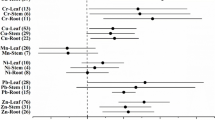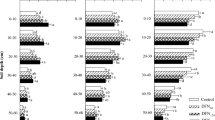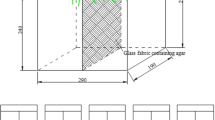Abstract
Background
Poplars accumulate inordinate amounts of B in their leaves and are candidate plants for the remediation of B contaminated soil. We aimed to determine the effect of heterogeneous B distribution in soil by comparing the growth and B accumulation of young Populus tremula trees growing in soil with heterogeneous and homogeneous B distributions.
Methods
The first of two experiments focused on the tolerance and B accumulation of P. tremula under heterogeneous soil B distributions, while the second was designed to study fine root growth under such conditions in detail.
Results
Growth and B accumulation of P. tremula were unaffected by the spatial distribution of B. Root and shoot growth were both reduced simultaneously when leaf B concentrations increased above 800 mg kg−1. In the heterogeneous soil B treatments, root growth was more reduced in spiked soil portions with B concentrations >20 mg kg−1. Fine root length growth was stronger inhibited by B stress than secondary growth.
Conclusions
The root growth responses of P. tremula to B are primarily a systemic effect induced by shoot B toxicity and local toxicity effects on roots become dominant only at rather high soil B concentrations. Local heterogeneity in soil B should have little influence on the phytoremediation of contaminated sites.









Similar content being viewed by others
Abbreviations
- B:
-
Boron
- NR:
-
Neutron radiography
- FR:
-
Fine roots
References
Aquea F, Federici F, Moscoso C, Vega A, Jullian P, Haseloff JIM, Arce-Johnson P (2011) A molecular framework for the inhibition of Arabidopsis root growth in response to boron toxicity. Plant Cell Environ doi:10.1111/j.1365-3040.2011.02446.x
Audet P, Charest C (2008) Allocation plasticity and plant-metal partitioning: meta-analytical perspectives in phytoremediation. Environ Pollut 156:290–296
Bañuelos GS, LeDuc D, Johnson J (2010) Evaluating the tolerance of young hybrid poplar trees to recycled waters high in salinity and boron. Int J Phytoremediat 12:419–439
Bell RW (1997) Diagnosis and prediction of boron deficiency for plant production. Plant Soil 193:149–168
Bellaloui N, Brown PH, Dandekar AM (1999) Manipulation of in vivo sorbitol production alters boron uptake and transport in tobacco. Plant Physiol 119:735–741
Blevins DG, Lukaszewski KM (1998) Boron in plant structure and function. Annu Rev Plant Physiol Plant Mol Biol 49:481–500
Borken W, Kossmann G, Matzner E (2007) Biomass, morphology and nutrient contents of fine roots in four Norway spruce stands. Plant Soil 292:79–93
Breckle SW, Kahle H (1992) Effects of toxic heavy-metals (Cd, Pb) on growth and mineral-nutrition of beech (Fagus-Sylvatica). Vegetatio 101:43–53
Brown PH, Hu HN (1996) Phloem mobility of boron is species dependent: evidence for phloem mobility in sorbitol-rich species. Ann Bot 77:497–505
Communar G, Keren R, Li F (2004) Deriving boron adsorption isotherms from soil column displacement experiments. Soil Sci Soc Am J 68:481–488
Crews JT, Dick WA (1998) Liming acid forest soils with flue gas desulfurization by-product: growth of Northern red oak and leachate water quality. Environ Poll 103:55–61
Dell B, Huang LB (1997) Physiological response of plants to low boron. Plant Soil 193:103–120
Dos Santos Utmazian MN, Wieshammer G, Vega R, Wenzel WW (2007) Hydroponic screening for metal resistance and accumulation of cadmium and zinc in twenty clones of willows and poplars. Environ Poll 148:155–165
Evans CM, Sparks DL (1983) On the chemistry and mineralogy of boron in pure and mixed systems—a review. Commun Soil Sci Plan 14:827–846
Friend AL, Mobley JA, Ryan EA, Bradshaw HD (1999) Root growth plasticity of hybrid poplar in response to soil nutrient gradients. J Sust For 10:133–140
Goldberg S (1997) Reactions of boron with soils. Plant Soil 193:35–48
Goldberg S, Forster HS, Heick EL (1993) Temperature effects on boron adsorption by reference minerals and soils. Soil Sci 156:316–321
Gupta UC, Jame YW, Campbell CA, Leyshon AJ, Nicholaichuk W (1985) Boron toxicity and deficiency—a review. Can J Soil Sci 65:381–409
Hall JB (1971) Pattern in a chalk grassland community. J Ecol 59:749–762
Himmelbauer ML, Loiskandl AW, Kastanek AF (2004) Estimating length, average diameter and surface area of roots using two different image analyses systems. Plant Soil 260:111–120
Hoagland DR, Arnon DI (1938) The water-culture method for growing plants without soil. Calif Agric Exp Stn Circ 357:1–39
Hu H, Brown PH (1997) Absorption of boron by plant roots. Plant Soil 193:49–58
Ishak CF, Seaman JC, Miller WP, Sumner M (2002) Contaminant mobility in soils amended with fly ash and flue-gas gypsum: intact soil cores and repacked columns. Water Air Soil Poll 134:285–303
Kabata-Pendias A, Pendias H (2001) Trace elements in soils and plants. CRC Press, Boca Raton
Lehmann EH, Vontobel P, Wiezel L (2001) Properties of the radiography facility NEUTRA at SINQ and its potential for use as European reference facility. Nondest Test Eval 16:191–202
Lehto T, Ruuhola T, Dell B (2010) Boron in forest trees and forest ecosystems. For Ecol Manage 260:2053–2069
Liu F, Tang Y, Du R, Yang H, Wu Q, Qiu R (2010) Root foraging for zinc and cadmium requirement in the Zn/Cd hyperaccumulator plant Sedum alfredii. Plant Soil 327:365–375
Lohmus K, Truu J, Truu M, Kaar E, Ostonen I, Alma S, Kuznetsova T, Rosenvald K, Vares A, Uri V et al (2006) Black alder as a perspective deciduous species for reclaiming of oil shale mining areas. In: Brebbia CA, Mander Ü (eds) Brownfields III prevention, assessment, rehabilitation and development of Brownfield sites. WIT Press, Southampton, pp 87–97
Luster J, Gottlein A, Nowack B, Sarret G (2009) Sampling, defining, characterising and modeling the rhizosphere-the soil science tool box. Plant Soil 321:457–482
Mastromatteo E, Sullivan F (1994) Summary- International Symposium on the health-effects of boron and its compounds. Environ Health Perspect 102:139–141
McLaren RG, Cameron KC (1996) Soil science: sustainable production and environmental protection. Oxford University Press, Oxford
Menon M, Hermle S, Günthardt-Goerg M, Schulin R (2007a) Effects of heavy metal soil pollution and acid rain on growth and water use efficiency of a young model forest ecosystem. Plant Soil 297:171–183
Menon M, Robinson B, Oswald SE, Kaestner A, Abbaspour KC, Lehmann E, Schulin R (2007b) Visualization of root growth in heterogeneously contaminated soil using neutron radiography. Eur J Soil Sci 58:802–810
Millis PR, Ramsey MH, John EA (2004) Heterogeneity of cadmium concentration in soil as a source of uncertainty in plant uptake and its implications for human health risk assessment. Sci Total Environ 326:49–53
Miwa K, Fujiwara T (2010) Boron transport in plants: co-ordinated regulation of transporters. Ann Bot 105:1103–1108
Moradi AB, Conesa HM, Robinson B, Lehmann E, Kuehne G, Kaestner A, Oswald S, Schulin R (2009a) Neutron radiography as a tool for revealing root development in soil: capabilities and limitations. Plant Soil 318:243–255
Moradi AB, Conesa HM, Robinson BH, Lehmann E, Kaestner A, Schulin R (2009b) Root responses to soil Ni heterogeneity in a hyperaccumulator and a non-accumulator species. Environ Pollut 157:2189–2196
Mulia R, Dupraz C (2006) Unusual fine root distributions of two deciduous tree species in southern france: what consequences for modelling of tree root dynamics? Plant Soil 281:71–85
Nable RO, Banuelos GS, Paull JG (1997) Boron toxicity. Plant Soil 193:181–198
Nowack B, Rais D, Frey B, Menon M, Schulin R, Guenthardt-Goerg MS, Luster J (2006) Influence of metal contamination on soil parameters in a lysimeter experiment designed to evaluate phytostabilization by afforestation. For Snow Landsc Res 80:201–211
Ostonen I, Puttsepp U, Biel C, Alberton O, Bakker MR, Lohmus K, Majdi H, Metcalfe D, Olsthoorn AFM, Pronk A et al (2007) Specific root length as an indicator of environmental change. Plant Biosyst 141:426–442
Parks JL, Edwards M (2005) Boron in the environment. Crit Rev Environ Sci Techn 35:81–114
Popko J, Hansch R, Mendel RR, Polle A, Teichmann T (2010) The role of abscisic acid and auxin in the response of poplar to abiotic stress. Plant Biol 12:242–258
Power PP, Woods WG (1997) The chemistry of boron and its speciation in plants. Plant Soil 193:1–13
Pregitzer KS, Friend AL (1996) The structure and function of Populus root systems. In: Stettler RF, Bradshaw HD Jr, Heilman PE, Hinckley TM (eds) Biology of Populus and its implications for management and conservation. National Research Council of Canada, Ottawa, pp 331–354
Pulford ID, Watson C (2003) Phytoremediation of heavy metal-contaminated land by trees—a review. Environ Int 29:529–540
Qin RJ, Hirano Y, Brunner I (2007) Exudation of organic acid anions from poplar roots after exposure to Al, Cu and Zn. Tree Physiol 27:313–320
Rees R, Robinson BH, Menon M, Lehmann E, Guenthardt-Goerg MS, Schulin R (2011) Boron accumulation and toxicity in hybrid poplar (Populus nigra x euramericana). Environ Sci Technol 45:10538–10543
Regent Instruments (2009) WinRhizo Pro. 2009c Regent Instruments
Reid RJ, Hayes JE, Post A, Stangoulis JCR, Graham RD (2004) A critical analysis of the causes of boron toxicity in plants. Plant Cell Environ 27:1405–1414
Robinson D (1994) The responses of plants to non-uniform supplies of nutrients. New Phytol 127:635–674
Robinson BH, Green SR, Chancerel B, Mills TM, Clothier BE (2007) Poplar for the phytomanagement of boron contaminated sites. Environ Pollut 150:225–233
Robinson BH, Banuelos G, Conesa HM, Evangelou MWH, Schulin R (2009) The phytomanagement of trace elements in soil. Crit Rev Plant Sci 28:240–266
Salisbury FB, Ross CW (1992) Plant physiology. Wadsworth Publishing Co. Inc., Belmont
Schwartz C, Morel JL, Saumier S, Whiting SN, Baker AJM (1999) Root development of the Zinc-hyperaccumulator plant Thlaspi caerulescens as affected by metal origin, content and localization in soil. Plant Soil 208:103–115
Systat Software (2008) Sigma Plot 11. Systat Software Inc.
Tanaka M, Fujiwara T (2008) Physiological roles and transport mechanisms of boron: perspectives from plants. Pflugers Archiv-Eur J Physiol 456:671–677
Tuskan GA, DiFazio S, Jansson S, Bohlmann J, Grigoriev I, Hellsten U, Putnam N, Ralph S, Rombauts S, Salamov A et al (2006) The genome of black cottonwood, Populus trichocarpa (Torr. & Gray). Science 313:1596–1604
Van TK, Kang Y, Sakurai K (2005) Boron fixation and its release in soils and bark compost. Soil Sci Plant Nutr 51:69–74
Wenzel W (2009) Rhizosphere processes and management in plant-assisted bioremediation (phytoremediation) of soils. Plant Soil 321:385–408
Whiting SN, Leake JR, McGrath SP, Baker AJM (2000) Positive responses to Zn and Cd by roots of the Zn and Cd hyperaccumulator Thlaspi caerulescens. New Phytol 145:199–210
Worrell R (1995) European aspen (Populus tremula L.): a review with particular reference to Scotland I. Distribution, ecology and genetic variation. Forestry 68:93–105
Xu F, Goldbach HE, Brown PH, Bell RW, Fujiwara T, Hunt CD, Goldberg S, Shi L (eds) (2007) Advances in plant and animal boron nutrition. Springer, Dordrecht
Zobel RW (2008) Hardware and software efficacy in assessment of fine root diameter distributions. Comput Electron Agr 60:178–189
Acknowledgments
Funds for this study came from the Swiss National Science Foundation (SNSF). Funding for M.W.H. Evangelou came from the DFG (Deutsche Forschungsgemeinschaft). The technical assistance provided by S. Hartmann and P. Vontobel from PSI is gratefully acknowledged. We would also like to thank N. Grisel from the Swiss Federal Institute for Forest, Snow and Landscape Research (WSL) for the poplar cuttings. We would also like to thank H. M. Conesa for accepting to pre-review the manuscript and two anonymous reviewers for their very helpful review comments.
Author information
Authors and Affiliations
Corresponding author
Additional information
Responsible Editor: Juan Barcelo.
Rights and permissions
About this article
Cite this article
Rees, R., Robinson, B.H., Evangelou, M.W.H. et al. Response of Populus tremula to heterogeneous B distributions in soil. Plant Soil 358, 403–415 (2012). https://doi.org/10.1007/s11104-012-1183-x
Received:
Accepted:
Published:
Issue Date:
DOI: https://doi.org/10.1007/s11104-012-1183-x




